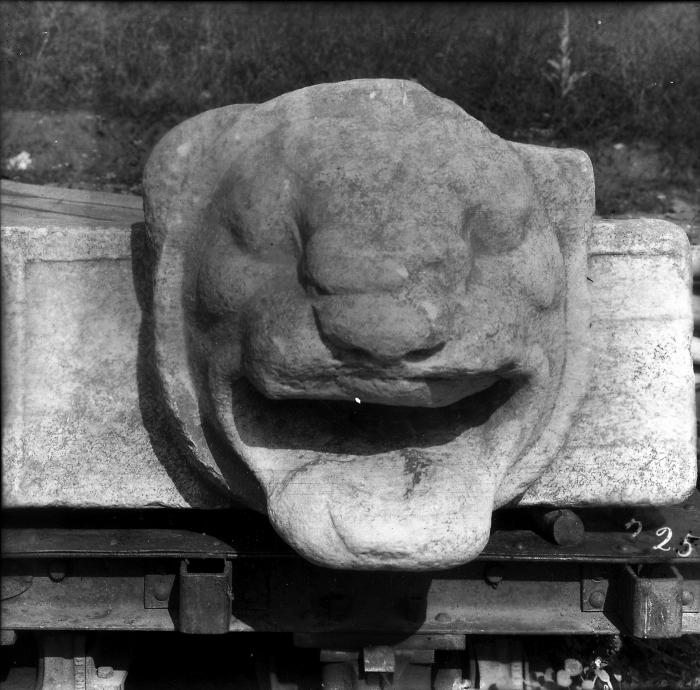Lion Spout Attached to Rectangular Member
- Date
- Lydian?
- Museum
- Istanbul, Archaeological Museum, 4047
- Museum Inventory No.
- 4047
- Sardis or Museum Inv. No.
- IAM 4047
- Material
- Marble, Stone
- Object Type
- Sculpture
- Sculpture Type
- Animal, Other Architectural Piece, Lion
- Site
- Sardis
- Findspot
- Found "near the northeast angle of the peristyle [of the AT] at a height of about four meters above the base of the angle column" (Sardis I, 96, ill. 99).
- Description
"This [colossal lion's head] in all probability belonged to the cornice of the temple and when in place, stood in a position almost directly above the spot where it was found, being the water-spout nearest the corner of the temple. The scale of the head is sufficiently large to have matched the scale of the building. The face of the lion was not executed on the cornice itself, but upon a separate block, provided with a sort of collar by means of which it was held in the face of the cornice. The block extends well back from the head, and its upper surface bears the cutting for the gutter which opens into the orifice in the lion's mouth . . . It seems probable that this head which bears on its upper surface the marks of long exposure to the weather, was in place for a long time after the temple was abandoned; and until four or five meters of debris had accumulated . . . when it finally fell uninjured upon soft earth" (Sardis I, 96).
"This lion spout was apparently set in the sima and protruding through it. The drawings (ill. 46) show how this was done. The face of the lion ... projects from a surface partly smooth, partly picked, and not from the middle of the block but from near the right end. All about the face is a kind of collar, the surface of which is lightly picked and was not intended to be seen. This . . . shows that the head was either set in a hole cut in the sima to fit it, or was placed between two sections of the sima, each carved with a roughly semicircular cavity at the end ... The block was broken off at the back, but originally extended well behind the face of the sima, where its weight served to balance the ponderous head. The orifice of the mouth grows wider, as it extends through the head, and formerly connected with a gutter at the back" (Sardis II, 51f., ill. 46).
The crucial questions are: whether the piece is finished and whether it came at an inner corner. If it did, it cannot come from the temple. Renewed examination by F.K. Yegül in 1975 showed that the piece "does not indicate a 'typical' inner corner detail: the sides are cut straight. Both sides display anathyrosis, hence they were certainly joined to other stones. It is possible, however, to form an inner corner by placing the piece on the left of the spout at right angles. I believe this kind of straight jointing was quite common. The rough and chiseled area to the left of the spout on the face of the stone should not be taken necessarily as an indication of a joint and an interior corner since the side of the piece is clearly prepared to receive another one by the application of anathyrosis" (by letter June 1975).
Careful multiple tooth work in the rectangle around the head and flat chisel-drove work on top of the lion's "collar" are both consistent with a 5th or 4th C. date. The characteristics of cavernous mouth and deep nostrils and eye corners, however, which Butler explains as calculated for view at a great distance from the ground, seem more Hellenistic or even Roman. According to Yegül, it could perfectly well be Roman work.
- Condition
Marble.
Unfinished. Block broken off at back.
- Dimensions
- L. 1.40; H. of head 0.60; W. of head 0.60; D. with head1.00; D. to sima 0.35. For detailed dimensions see Fig 412.
- Comments
- See Also
- Bibliography
- Published: Sardis I, 96, ill. 99; Sardis II, 51f., 73f., figs. 46, 84f.
- Author
- NHR
















